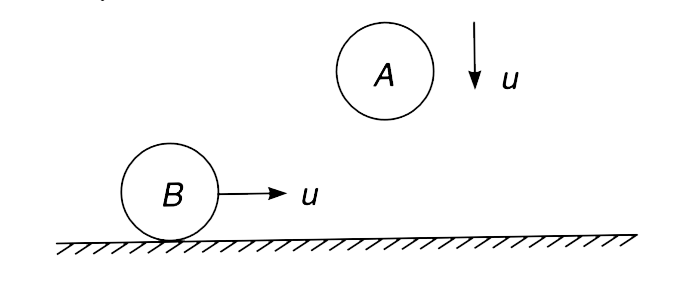Two identical balls .A. and .B. are moving with same velocity. If velocity of .A. is reduced to half and of .B. to zero, then the rise in temperatures of .A. to that of .B. is
3:4
4:1
2:1
1:1
The correct Answer is:A
Topper's Solved these Questions
- CALORIMETRY BOOK - AAKASH SERIESCHAPTER - CALORIMETRY EXERCISE - PRACTICE SHEET (LEVEL - II Straight Objective Type Questions)
25 Videos
- CALORIMETRY BOOK - AAKASH SERIESCHAPTER - CALORIMETRY EXERCISE - PRACTICE SHEET (LEVEL - II More than One correct Type Questions)
5 Videos
- CALORIMETRY BOOK - AAKASH SERIESCHAPTER - CALORIMETRY EXERCISE - LECTURE SHEET (Matirx Matching Type Questions)
2 Videos
- APPENDICES BOOK - AAKASH SERIESCHAPTER - APPENDICES EXERCISE - GRAVITATION (EARTH SATELLITES AND ESCAPE SPEED)
35 Videos
- CENTRE OF MASSBOOK - AAKASH SERIESCHAPTER - CENTRE OF MASSEXERCISE - ADDITIONAL PRACTICE EXERCISE (PRACTICE SHEET (ADVANCED))
3 Videos
Similar Questions
Two particles A and B are moving with the same velocity but wavelength of A is found to be double than that of B. What do you conclude ?
View SolutionTwo identical balls A and B are moving as shown in the fig. Ball A hits a smooth floor head on with a velocity u and at the same instant ball B strikes A head on with a horizontal velocity u. The collision between A and B is perfectly inelastic whereas the coefficient of restitution for collision between A and the floor is e=0.5. At what time the two balls will collide again? Assume friction to be absent everywhere.

View Solution
Knowledge Check
Two identical balls 'A' and 'B' are moving with same velocity. If velocity of 'A' is reduced to half and of 'B' to zero, then the rise in temperature of 'A' to that is reduced to half and of 'B' to zero, then the rise in temperature of 'A' to that of 'B' is
A3:4B4:1C2:1D1:1Two objects A and B are moving with the same velocity. The mass of object A is twice that of B. The ratio of the kinetic energy of A to that B, (KA/KB) will be _______.
A4B2C1D12There are two spherical balls A and B of the same material with same surface, but the diameter of A is half that of B . If A and B are heated to the same temperature and then allowed to cool, then
ARate of cooling is same in bothBRate of cooling of A is four times that of BCRate of cooling of A is twice that of BDRate of cooling of A is 14 times that of B
Two particles A and B moving in a plane have velocities as shown in figure .Relative velocity of A w.r.t B
View SolutionIf the heat energy abosrobed by two identical bodies A and B is 1 calorie and 1 joule, repsectively, the rise in temperature of A is greater than the rise in temperature of B.
View SolutionIf the heat energy abosrobed by two identical bodies A and B is 1 calorie and 1 joule, repsectively, the rise in temperature of A is greater than the rise in temperature of B.
View SolutionTwo balls A and B. are of the sme size but the mass of A is double that of B. they move along the sme line in opposite direction. A with velocity 2μ and B with velocity 3μ If their total kinetoc energy after collision is half their total kinetic energy before collision find the coefficient of restitution. Find also their velocities after collision.
View SolutionTwo identical balls A and B collide head on elastically. If velocities of A and B, before the collision are +0.5msand−0.3ms respectively, then their velocities, after the collision, are respectively
View Solution
